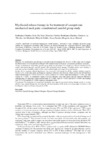Mostrar o rexistro simple do ítem
Myofascial release therapy in the treatment of occupational mechanical neck pain: a randomized parallel group study
| dc.contributor.author | Rodríguez Fuentes, Iván | |
| dc.contributor.author | De-Toro, Javier | |
| dc.contributor.author | Rodríguez Fuentes, Gustavo | |
| dc.contributor.author | Oliveira, Iris Machado de | |
| dc.contributor.author | Meijide-Faílde, Rosa | |
| dc.contributor.author | Fuentes Boquete, Isaac Manuel | |
| dc.date.accessioned | 2016-06-29T11:47:49Z | |
| dc.date.issued | 2016-07 | |
| dc.identifier.citation | Rodríguez-Fuentes I, De Toro FJ, Rodríguez-Fuentes G, Oliveira IM, Meijide-Failde R, Fuentes-Boquete I. Myofascial release therapy in the treatment of occupational mechanical neck pain: a randomized parallel group study. Am J Phys Med Rehab. 2016;95(7):507-515 | es_ES |
| dc.identifier.uri | http://hdl.handle.net/2183/16970 | |
| dc.description.abstract | [Abstract] Objective: As myofascial release therapy is currently under development, the objective of this study was to compare the effectiveness of myofascial release therapy with manual therapy for treating occupational mechanical neck pain. Design: A randomized, single-blind parallel group study was developed. The sample (n = 59) was divided into GI, treated with manual therapy, and GII, treated with myofascial release therapy. Variables studied were intensity of neck pain, cervical disability, quality of life, craniovertebral angle, and ranges of cervical motion. Results: At five sessions, clinical significance was observed in both groups for all the variables studied, except for flexion in GI. At this time point, an intergroup statistical difference was observed, which showed that GII had better craniovertebral angle (P = 0.014), flexion (P = 0.021), extension (P = 0.003), right side bending (P = 0.001), and right rotation (P = 0.031). A comparative analysis between therapies after intervention showed statistical differences indicating that GII had better craniovertebral angle (P = 0.000), right (P = 0.000) and left (P = 0.009) side bending, right (P = 0.024) and left (P = 0.046) rotations, and quality of life. Conclusions: The treatment of occupational mechanical neck pain by myofascial release therapy seems to be more effective than manual therapy for correcting the advanced position of the head, recovering range of motion in side bending and rotation, and improving quality of life. | es_ES |
| dc.language.iso | eng | es_ES |
| dc.publisher | Wolters Kluwer | es_ES |
| dc.relation.uri | http://dx.doi.org/10.1097/PHM.0000000000000425 | es_ES |
| dc.rights | This is a non-final version of an article published in final form in the American Journal of Physcial Medicine & Rehabilitation | es_ES |
| dc.subject | Fascia/Pathology | es_ES |
| dc.subject | Manual therapy | es_ES |
| dc.subject | Neck pain | es_ES |
| dc.subject | Physical therapy modalities | es_ES |
| dc.title | Myofascial release therapy in the treatment of occupational mechanical neck pain: a randomized parallel group study | es_ES |
| dc.type | info:eu-repo/semantics/article | es_ES |
| dc.rights.access | info:eu-repo/semantics/embargoedAccess | es_ES |
| dc.date.embargoEndDate | 2017-07-01 | es_ES |
| dc.date.embargoLift | 2017-07-01 | |
| UDC.journalTitle | American Journal of Physical Medicine & Rehabilitation | es_ES |
| UDC.volume | 95 | es_ES |
| UDC.issue | 7 | es_ES |
| UDC.startPage | 507 | es_ES |
| UDC.endPage | 515 | es_ES |
Ficheiros no ítem
Este ítem aparece na(s) seguinte(s) colección(s)
-
GI-TCMR - Artigos [123]
-
INIBIC-TCMR - Artigos [102]






